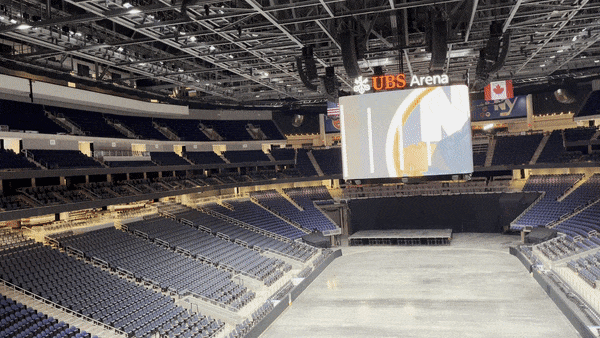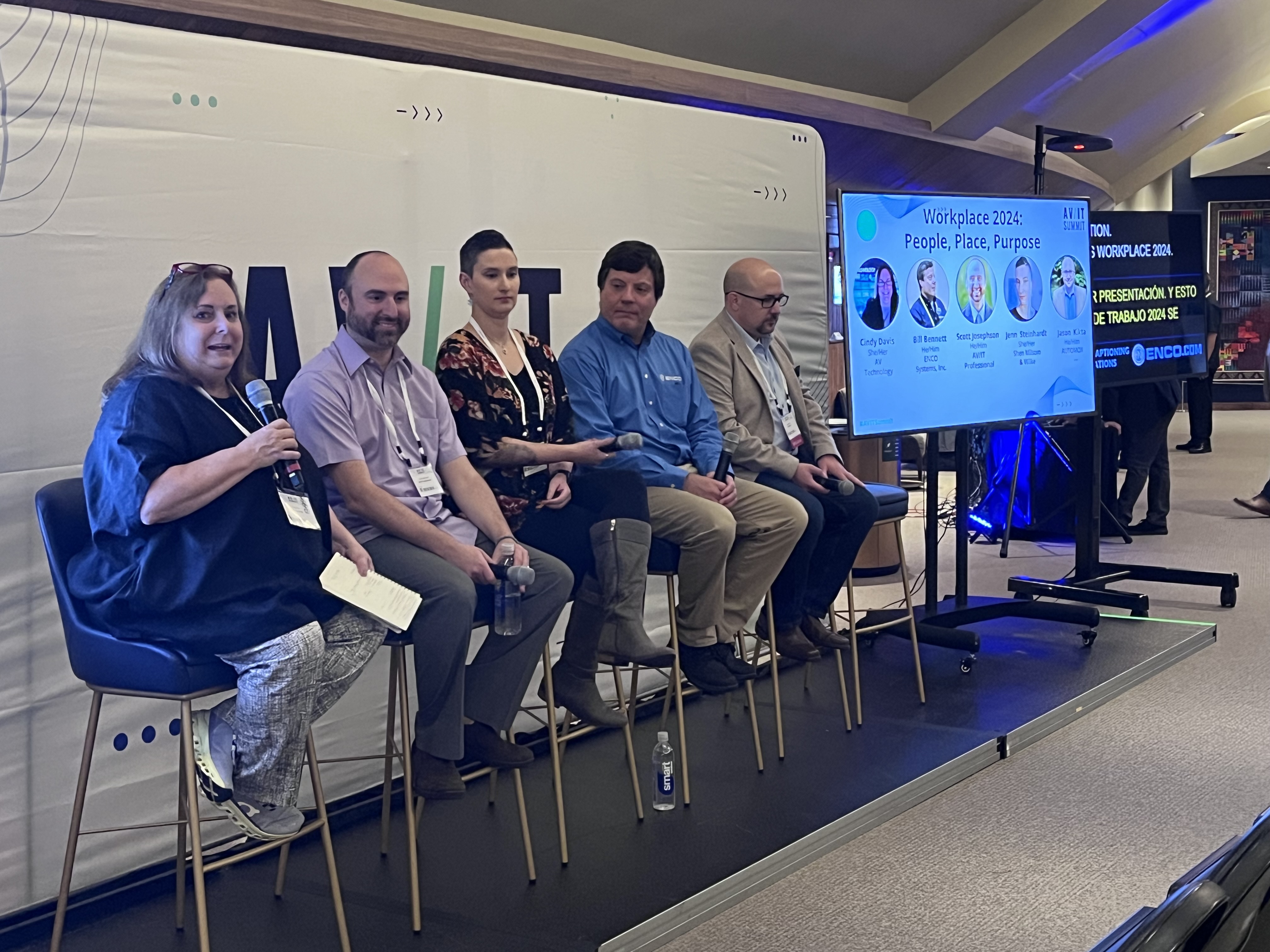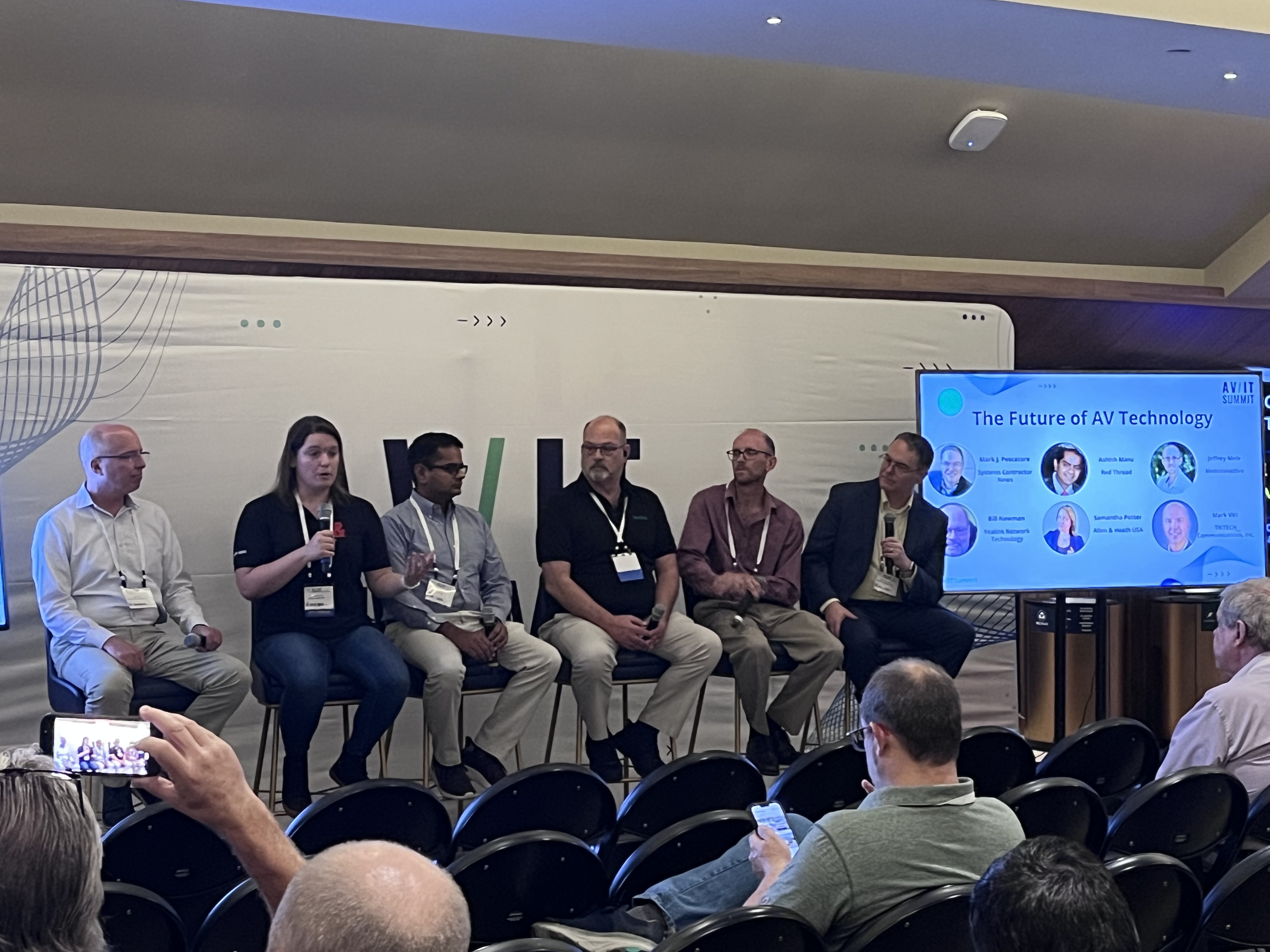What We Learned at the 2023 AV/IT Summit
Here are 5 takeaways from this year's event, held at the home of the New York Islanders, the UBS Arena.

The 2023 AV/IT Summit, held at the UBS Arena in New York City, is in the books. The home of NHL’s New York Islanders hosted more than 150 attendees in a day full of insightful technological conversation and a look behind the AV scenes at the Long Island arena.
Some of the Pro AV and IT industry’s most knowledgeable sources joined AV Technology’s Cindy Davis, SCN’s Mark J. Pescatore, and TV Technology’s Tom Butts to explore where AV and IT are headed—and some of the challenges that need to be overcome to get there.
Here are a few highlights about what was discussed.
Start Asking the Right Questions for Hybrid Workplaces

The AV/IT Summit kicked off with keynote speaker Kay Sargent, senior principal and director of WorkPlace at HOK (and 2022 SCN Hall of Famer), examining what the hybrid world should look like now and in the future. As Sargent quickly pointed out, it is no longer about designing the right environments, but the right experiences.
In the early days of the pandemic, some of the largest concerns were health and safety, the shift to remote work, business resiliency, and the purpose of place. However, just two years later, the focus has shifted. Now, instead of making people comfortable working from home, we are focused on what makes the right mix for the hybrid workforce, taking in considerations such as optimizing office space, downsizing real estate, and changing employee behavior.
[SCN Hybrid World Review: Biamp Helps You Read the Room]
Simply put, it is time to start asking the right questions and measuring the right information. Why should an employee battle long commutes and come to the office? What can you give employees that’s better than what they are getting at home? Are we measuring how much people are achieving or focusing on the quality of what they are achieving? Is the office not only tech enabled, but tech enhanced for employees making the trek into the office?
A daily selection of the top stories for AV integrators, resellers and consultants. Sign up below.
Sargent said that 25-50% of the workforce was hired during the pandemic, so they know no other way than the hybrid world. It is important to make the distinction that hybrid work is an operational model and not a workplace solution. It is also time to realize that hybrid work is not a one-size-fits-all mentality and IT setup.
We Live in a World of Videoconferencing

No, the Workplace 2024: People, Place, Purpose panel was not solely about videoconferencing, but we are kidding ourselves if we don't think it plays a large role in the current hybrid world. As Sargent pointed out in her keynote, 252% more time was spent in on online meetings during COVID-19 than before the pandemic. That's no small number...and not a lot has changed almost four full years later.
Scott Josephson, AV/IT professional, noted changes are coming rapidly and we see it in the acceleration of videoconferencing technology. With AI, cameras act as directors, finding the speaker and panning back and forth between participants. The importance of auto tracking brings the remote participant into the conversation and face-to-face with the speaker, and not a desk of colleagues. All-in-one videobars are the trend to watch right now and for the foreseeable future.
[Videoconferencing Award-Winners: What the Judges Had to Say]
However, with videoconferencing and remote meetings comes multitasking. Turn that camera off, and you can do two things at once until it is your turn to speak. Burnout from multitasking and overworking while participating in a meeting is a challenge, and so is producing quality work.
Where should we focus our attention moving forward in the workplace? For Josephson, it was to give the employee a choice and provide flexibility in regard to remote and in-person work with purpose. For Jenn Steinhardt of Shen Milsom & Wilke, it is time to rethink how spaces are being utilized and to ensure we are promoting collaboration and routine. Bill Bennett of ENCO focused on captioning and the importance of saving the transcripts so people can re-read when they need to.
But perhaps Jason Kikta of AUTOMOX said it best. He said it's time for companies to be the leading investment, not the trailing one. Companies can no longer implement based on decisions that came before—but be a trailblazer and stay ahead of the curve.
Campus Technology of Tomorrow

It’s hard to remember, but just a few short years ago, people wondered if anyone would ever return to the classroom. Now, of course, students and teachers are back, and a lot of the technology installed is not necessarily being used for the same intent. As Joe Way, co-founder and chair of HETMA, explained, education is still very much tangible and not all virtual and digital.
Take for example, some of the collaboration tools used during the pandemic for remote learning. Jonathan Kornberg from the Columbia University Medical Center said those collaboration solutions are being used for lecture capture, not remote meetings or classes. At Way's home of University of Southern California, it is actually a requirement, though that didn't ring true on other campuses.
Originally a concern, professors were worried work or research would leave campus (a YouTube spoiler, perhaps), but that never seemed to happen. Students immediately took to the recordings as a side bonus, but now it is the expectation. This helps students who learn differently or are non-native English speakers.
[What to Know about HETMA's Prism Scholarship]
While small percentages of colleges are still utilizing the hybrid learning model done during the pandemic, it is all about getting students back in their seats. So, what are the conversations vendors should be having with higher ed professionals to make that a comfortable return?
According to Kornberg, it starts with ceiling mics and mics for large spaces, lecture capture, and types of audio devices for recording and live events. Cameras are still very important, in particular those powered by AI. Erin Maher-Moran from Johns Hopkins University added that everything should be simple and flexible, allowing educators to get the bells and whistles by simply pressing a button. Also, and somewhat surprisingly, the need for chalkboard capture cameras is larger than ever, as many faculty haven't adapted to the whiteboard. Tim Van Woeart from Rutgers University said there is once again a big push for active learning (the pre-COVID buzzword) and a reliable, easy-to-use AV-over-IP solution is the way to go in active learning spaces over multiple networks connecting multiple campuses miles apart.
And, of course, there is AI technology in the classroom. Right now, it seems teachers will teach, and AI will be reserved for technologies like camera and microphone tracking. As Maher-Moran mentioned and Way agreed, the hope is that one day soon AI can serve as an assistant to make the classroom a little more robust—to contact facility IT to enhance the atmosphere or detect a system malfunction before it is an issue. The important takeaway is that in the classroom, AI is a tool, not an end-all solution.
Ease of Use and Installation is the Future of AV

SCN's own Mark J. Pescatore gathers a panel every year and asks the same question: What is the future of Pro AV? Last year, topics like Microsoft Teams/Zoom/UC, bandwidth, and HDBaseT dominated the conversation. This year buzzwords and big ideas like virtual and remote production, meeting equity, and, to no one's surprise, AI were at the forefront.
When it comes to AI, Bill Newman of Yealink Network Technology explained it should be about the user experience. Device-level intelligence makes it easier to capture experiences and helps today's technologies get ahead of the curve instead of being behind it. Of course, with any extended conversation on AI, ethical concerns arise, and that's why Newman was quick to note that in the world of AV, it is about intent— and that intent is to make life easier and enhanced on the end user.
[Lions, and Tigers, and Dinosaurs, Oh My—Check out the Hologram Zoo]
Words like "approachable" and "easy to use" were common themes throughout the conversation. Samantha Potter from Allen & Heath USA explained that during the pandemic, a lot of fun, innovative technology was created—and now that we have it, we need to use it and make it easy to use. Mark Vitt from TRITECH Communications agreed; no matter how many cameras, displays, and microphones bring a conference room together, the technology needs to be approachable.
And speaking of conference rooms, what's in the dream conference room of the future? Jeff Mele of Metinteractive felt attendees should be able to experience and interact seamlessly just like they’re at home. For Red Thread's Ashish Maru, the ideal conference room is the one in which the technology doesn’t get in the way. Let the presenter present and let AI handle the camera angles and voice tracking. The panelists agreed that technology has to be easy to use for the end user and easy to install for the integrators. The ecosystem is just fine where it is, but the potential for an enhanced digital future is limitless.
Stadium Technology Is Cool
As with last year's AV/IT Summit at Citi Field, home of MLB's New York Mets, the location of the summit was a multipurpose sports venue. UBS Arena is home to the Islanders, but also events, concerts, and shows.
Ryan Halkett of the New York Islanders and Steve Stubelt of Diversified discussed how building the new UBS Arena from the ground up was all about one thing: the fan experience and enhancement of going to a game for what they called the "home ice advantage." Technology had to be the driving force to enable that enhanced experience.
[Watch This: New York Islanders, JBL Help Fans Feel the Emotion Through Sound]
Islanders fans had been through a lot prior to UBS Arena, with an aging Nassau Coliseum and the Barclays era. Halkett and Stubelt worked together to make the arena, which opened in 2021, an innovative experience to bring back the old Islanders fans and create new ones.
As Halkett said, "Fans love experiencing the building. They finally have a home and more importantly, they feel like it’s their home."
Here, see for yourself.

Wayne Cavadi is the senior content manager of Systems Contractor News. Prior to taking a leap into the Pro AV industry, Wayne was a journalist and content lead for Turner Sports, covering the NCAA, PGA, and Major and Minor League Baseball. His work has been featured in a variety of national publications including Bleacher Report, Lindy's Magazine, MLB.com and The Advocate. When not writing, he hosts the DII Nation Podcast, committed to furthering the stories and careers of NCAA Division II student-athletes. Follow his work on Twitter at @WayneCavadi_2 or the SCN mag Twitter page.
